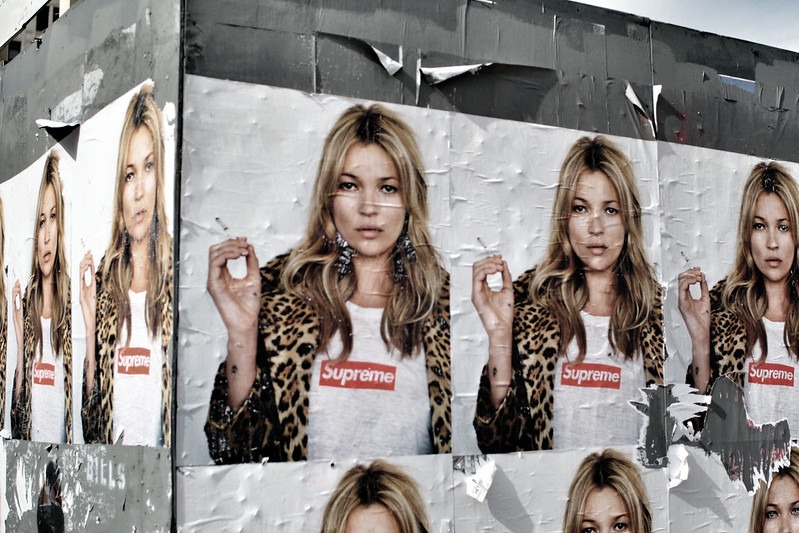Threads of Time: The fabrics of 90s and 00s Britain, a cultural history of ‘Cool Britannia’
In the late 1990s, there was a renewed global interest in British art, fashion, design and music, which critics saw as a different, modern form of patriotism, a new way of being British. Kate Moss, one of the faces of the ‘Cool Britannia’ period, became internationally recognised as a high fashion icon and her British, or specifically London, origins became inseparable from her identity. Described as the “Cocky Kid From Croydon”, Kate Moss’ rise into the high fashion world also marked the rise of the ‘Cool Britannia period’, walking runways for British names which garnered incredible success, such as Vivienne Westwood, Alexander McQueen and John Galliano. Furthermore, Gerri Halliwell’s 1997 Brit Awards Union Jack dress, a famously last-minute outfit decision that became forever iconic, marked the Union Jack as an international fashion symbol, featuring in clothing, interiors and art.
‘Cool Britannia’ was not conservative, nor xenophobic, but rather against the grain, gritty, alternative, and an exuberant celebration of the new British youth
So, what is the social and cultural history behind these iconic fashion moments, and the high fashion of the time overall? In 1997, Tony Blair was elected Prime Minister, with this period seeing an expanding economy and low inflation. In fact, the phrase ‘Cool Britannia’ was originally used to characterise the economy’s recovery and the celebration of the Labour Party’s most significant victory following eighteen years of Conservative rule. This shows the interconnection between the economy, art, music, and fashion, but also captures the feel of this new British patriotism; a period soundtracked by bright, catchy rock from Britpop bands such as Oasis and Blur, as well as fun, ‘girl power’ hits from groups like the Spice Girls. ‘Cool Britannia’ was not conservative, nor xenophobic, but rather against the grain, gritty, alternative, and an exuberant celebration of the new British youth. Indeed, many sub-genres of Britpop, such as Madchester, were characteristically working-class, demonstrating how ‘Cool Britannia’ incorporated voices from all classes and backgrounds. Moreover, the movement, including the music and fashion, was inspired by the 1960s, which was another period of a new youth alternative culture, marked by its music and punk styles of fashion.
In 2005, Moss was captured wading through the festival mud in a sheer shimmery gold dress, a black belt and Hunter wellies
In this period, the most famous manifestation of global interest in the Britpop genre was the iconic Glastonbury festival, which marketed itself as a left-wing, alternative, diverse festival of art and music, which aligned with the values of Britpop. Moss’ attendance at the festivals in the late 1990s and early 2000s is a direct link to high fashion with paparazzi shots of her festival outfits becoming iconic fashion moments in and of themselves. In 2005, Moss was captured wading through the festival mud in a sheer shimmery gold dress, a black belt and Hunter wellies. She was the ultimate ‘rock star girlfriend’, and her fashion moments at the festival demonstrate how fashion at the time was shaped by this left-wing, alternate British culture.
Another element of British cultural history framing high fashion of the time was the rise in popularity of quintessentially British films in the 1990s and 2000s. Bridget Jones’ Diary, Notting Hill, and Four Weddings and a Funeral were simple but iconic British romantic comedies, usually set in either London or some unnamed quaint village, starring awkward, ridiculously English heartthrobs (always played by Hugh Grant or Colin Firth), or the clumsy, romantically unfortunate ‘frazzled English woman’. The fashion of these Bridget Jones-esque films became iconic in its own right, characterised by lots of knits, cardigans, skinny scarves, vintage handbags, and long coats. This ‘frazzled English woman’ was reflected on the runway, most notably in Vivienne Westwood, seen in both her Fall/ Winter 1995 and her Spring/Summer 1996 runways, where Moss is sporting messy updos, cardigans, and statement necklaces.
Britain’s monarchic origins also translated onto the runway, with many of Kate Moss’ most famous walks of the 1990s witnessing her dressed in archaic, regal gowns
The global interest in the British culture was also directed to the new generation of royals, who had become young adults in this era. This period saw an emergence a new way the British monarchy was worshipped – a move from formal ceremonies to the pages of gossip magazines, with extensive coverage of the young royals’ daily activities, and personal lives. As they did with models like Kate Moss, the paparazzi also captured the antics of the royals, seen through the iconic pictures of Kate Middleton clubbing with Prince William, resulting with her becoming a fashion icon herself.
Britain’s monarchic origins also translated onto the runway, with many of Kate Moss’ most famous walks of the 1990s witnessing her dressed in archaic, regal gowns. In 2006, an exhibition celebrating British fashion opened in the Metropolitan Museum of Art, which interestingly placed the rising British fashion designers of the ‘Cool Britannia’ period (McQueen, Galliano, and Westwood) side-by-side with mannequins wearing traditional 18th and 19th century clothing, which shows how even the most alternative British designers drew inspiration from Britain’s monarchic history. This can be seen again in Kate Moss and Vivienne Westwood’s collaborations. In Westwood’s 1993 Fall/ Winter runway, Moss displays an incredible dress in a striking archaic silhouette, but in Westwood’s iconic tartan print, clearly demonstrating the blend between British royal history and the period’s punk culture, bringing together the true nature of ‘Cool Britannia’.

Comments